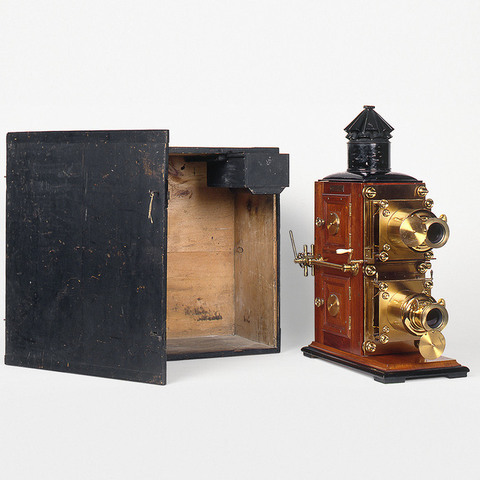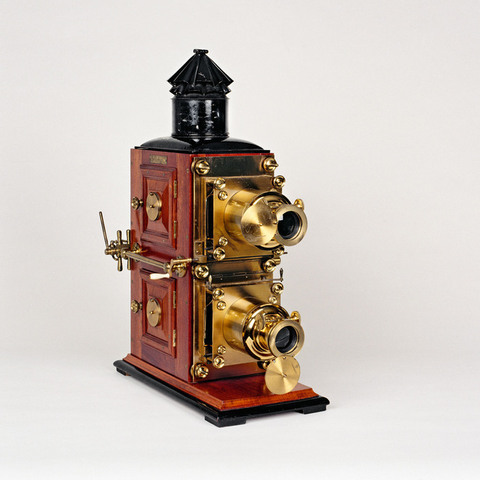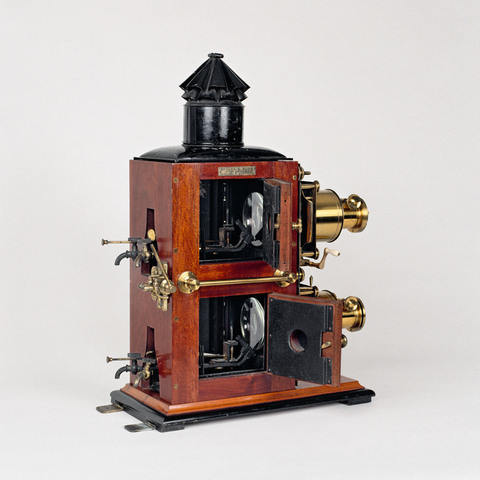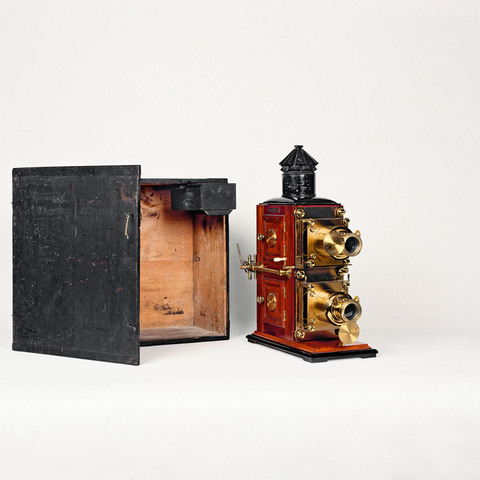Lanterne de projection
Fiche détaillée
Type de l'appareil
lanterne à deux étages, corps en acajou verni ; deux tubes optiques à crémaillère et réglables pour dissolving views ; cheminée ; manivelle pour rideau (absent) ; deux chalumeaux oxhydriques ; robinet fondant ; cheminée ; boîte de transport en bois
Auteurs
Informations non disponibles
Fabricants
Archer & Sons
Liverpool, 43 & 49 Lord Street
Utilisateurs
Informations non disponibles
Distributeurs
Archer & Sons
Liverpool, 43 & 49 Lord Street
Sujet du modèle
Informations non disponibles
Objectif
deux condensateurs, deux objectifs 7 et 4 "
Taille de l'objet
Ouvert :
Informations non disponibles
Fermé :
Longueur : 54 cm
Largeur : 31 cm
Hauteur : 68 cm
Diamètre :
Informations non disponibles
Taille de la boîte de transport
Longueur : 30 cm
Largeur : 63 cm
Hauteur : 57 cm
Remarques
Marque : "Archer & Sons, Lantern Specialists, 43-49 Lord St. Liverpool".
"Archer, English family of lantern and slide manufacturers and dealers in Liverpool (1857-1900s). The Archer business was founded by William Frederick Archer, a musical instrument dealer, who formed a partnership under the name Archer & Inch in 1857 (through the company later claimed 1848 as the year of its foundation), trading in optical and scientific instruments from 62 South Castle Street, Liverpool. In the 1860s the business was run in Archer's name alone. His son Walter J. Archer joined the firm in 1875 and took over its management after his father's death, probably in the early 1880s, at which time its adress changed to 60 South Castle Street. Walter Archer was joined in the business (by now known as Archer & Sons) by his brothers F.W. Archer and F.H. Archer, and they expanded into additional premises at 49 Lord Street. In the 1890s the South Castle Street shop was replaced by the acquisition of 49 Lord Street, and over subsequent years the adjoining properties were acquired until by 1896 Archer occupied the whole row of 43 to 49 Lord Street. In the late 1880s and 1890s Archer & Sons were probably one of the largest lantern manufacturers in the north of England. In the 1890s the company was organised into three departements, each managed by one of the brothers : one for lanterns and accessories, one for general optical goods, and one for photographic equipment. The premises also had a manufacturing workshop, in which "even the lathes are run by electric power" (Optical Magic Lantern Journal, 1896). Archer's range of lanterns included the Photinus (claimed to be "the most powerful oil-light lantern in the world"), the Excelsior and the Unilux, as well as the Ideal lecturer's lantern with its distinctive bellows-type tube connecting the lantern body to the movable lens. [...] In early 1899 Archer took over the business of another Liverpool dealer, Wood Brothers (successor of Abraham & Co.) and by 1901 had moved into the former Wood premises ar 73 Lord Street. The business was still running in 1904, at which time it claimed a stock of 75 000 slides for sale of hire and dealt in "everything connected with the Lantern and Cinematograph"" (Richard Crangle, Encyclopaedia of the Magic Lantern, London, The Magic Lantern Society, 2001, p. 18).
Bibliographie
Richard Crangle, Encyclopaedia of the Magic Lantern, London, The Magic Lantern Society, 2001, p. 18.



